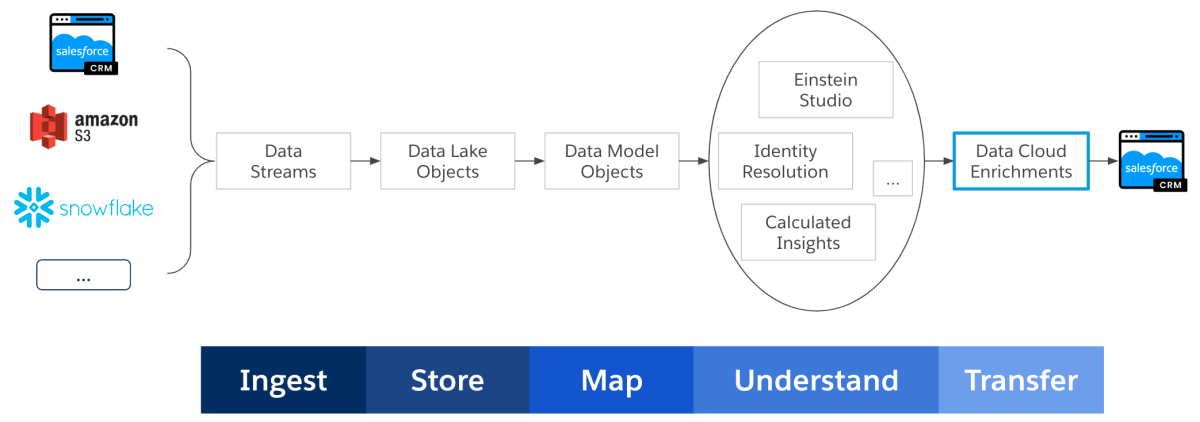
How Does Salesforce Data Cloud Copy Fields & Related Lists Bridge The Data Gap?
In today’s data-driven world, businesses are constantly striving to unify customer data across disparate systems. This unified view is crucial for understanding customer behavior, personalizing interactions, and driving growth. However, integrating data from external sources like Salesforce Data Cloud with your existing CRM system can be a challenge. This is where Salesforce Data Cloud Copy Fields and Related Lists come in, providing a seamless and efficient way to bridge the data gap.
What are Salesforce Data Cloud Copy Fields and Related Lists?
Salesforce Data Cloud Copy Fields and Related Lists are functionalities within the Data Cloud suite that enable you to enrich your Salesforce CRM with insights generated in the Data Cloud.
- Copy Fields – This feature allows you to map specific data points (fields) from Data Cloud objects (Data Model Objects or Calculated Insight Objects) directly to corresponding fields in your CRM objects (primarily Contacts and Leads). This creates a one-to-one correspondence, bringing valuable Data Cloud insights directly into the familiar CRM interface.
For instance, imagine you have a Data Cloud object capturing customer purchase history and sentiment analysis from social media. Using Copy Fields, you can map the “average purchase value” and “sentiment score” fields from the Data Cloud object to custom fields on the Contact object in Salesforce CRM. This enriches your CRM data with valuable customer insights, readily accessible to your sales and service teams.
- Related Lists – This functionality enables you to display relevant Data Cloud object records as related lists on specific CRM object detail pages. For instance, you can showcase a related list of “Purchase History” from the Data Cloud on a Contact record page, providing a holistic view of the customer’s buying behavior within the CRM itself.
Continuing with the example, you could create a Related List on the Contact detail page that displays the customer’s individual purchase history records stored in the Data Cloud object. This empowers your sales reps to understand customer preferences and tailor their interactions accordingly
Still Confused?
In even simpler terms, imagine you have a sales or service representative who relies on their CRM system for data. Their admin has set up some valuable insights in Data Cloud, but the rep doesn’t know how to access that data. They’re used to their CRM apps and don’t want to navigate through Data Cloud’s technical features.
So, Data Cloud Enrichments come in to make things easier.
- Copy Fields – Transfer data 1 : 1 from objects in Data Cloud to objects in CRM
- Related Lists – List records from Data Cloud objects on record homes of CRM Objects.

A simplistic illustration of how Data Cloud Enrichments fit into the Data Cloud Workflow
Image Source – Stefan Quaadgras @ salesforceblogger.com
Benefits of Utilizing Copy Fields and Related Lists
- Enhanced User Experience: By bringing Data Cloud insights directly into the CRM, you empower your sales, marketing, and service teams to access and utilize valuable customer data without switching between different platforms. This streamlines workflows, improves decision-making, and ultimately enhances the user experience. This also ensures that everyday users can access valuable insights seamlessly within their familiar workflows.
- Improved Data Consistency: Copy Fields ensure data consistency between your CRM and Data Cloud by directly replicating specific data points. This eliminates the risk of discrepancies and provides a unified view of your customer information.
- Actionable Insights: Related Lists offer a contextual view of relevant Data Cloud information directly within the CRM. This empowers your teams to leverage these insights for personalized interactions, targeted campaigns, and improved customer service.
A study by Gartner predicts that by 2025, 80% of organizations will leverage Customer Data Platforms (CDPs) like Data Cloud to unify customer data and gain deeper customer insights. This highlights the growing importance of CDPs and the need for seamless integration with existing CRM systems.
Real-World Use Cases
- Predictive Lead Scoring: Leveraging Data Cloud insights like purchase propensity or churn risk scores and copy them to Lead fields in your CRM. This helps sales teams to prioritize leads and allocate resources effectively.
- Personalized Marketing Campaigns: Utilizing Data Cloud insights like customer segmentation or behavioral trends and display them as related lists on Contact records. This allows marketing teams to personalize campaigns based on individual customer preferences and needs.
- Enhanced Customer Service: Enriching Contact records with Data Cloud insights like past service interactions or product usage patterns. This equips service agents with a deeper understanding of customer history, enabling them to provide more efficient and personalized support.
Conclusion
Salesforce Data Cloud Copy Fields and Related Lists offer a powerful and user-friendly solution to bridge the data gap between your CRM and Data Cloud. By bringing valuable insights directly into the CRM interface, these functionalities empower your teams to make data-driven decisions, personalize interactions, and ultimately drive business growth. As the capabilities of these features continue to evolve, they hold immense potential to revolutionize the way businesses leverage customer data for success in the ever-evolving digital landscape.
